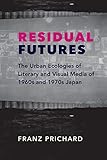Residual Futures : The Urban Ecologies of Literary and Visual Media of 1960s and 1970s Japan / Franz Prichard.
Material type: TextSeries: Studies of the Weatherhead East Asian Institute, Columbia UniversityPublisher: New York, NY : Columbia University Press, [2019]Copyright date: ©2019Description: 1 online resource : 20 illustrationsContent type:
TextSeries: Studies of the Weatherhead East Asian Institute, Columbia UniversityPublisher: New York, NY : Columbia University Press, [2019]Copyright date: ©2019Description: 1 online resource : 20 illustrationsContent type: - 9780231191319
- 9780231549332
- 307.760952 23
- online - DeGruyter
| Item type | Current library | Call number | URL | Status | Notes | Barcode | |
|---|---|---|---|---|---|---|---|
 eBook
eBook
|
Biblioteca "Angelicum" Pont. Univ. S.Tommaso d'Aquino Nuvola online | online - DeGruyter (Browse shelf(Opens below)) | Online access | Not for loan (Accesso limitato) | Accesso per gli utenti autorizzati / Access for authorized users | (dgr)9780231549332 |
Frontmatter -- Contents -- Acknowledgments -- Introduction -- Chapter One. Prelude to the Traffic War Infrastructural Aesthetics of the Cold War -- Chapter Two. Disappearance Topological Visuality in Abe Kōbō’s Urban Literature -- Chapter Three. Landscape Vocabularies For a Language to Come and the Geopolitics of Reading -- Chapter Four. An Illustrated Dictionary of Urban Overflows -- Chapter Five. Photography as Threshold and Pathway After Reversion -- Chapter Six. Residual Futures -- Notes -- Index
restricted access online access with authorization star
http://purl.org/coar/access_right/c_16ec
In the postwar years, an eruption of urbanization took place across Japan, from its historical central cities to the outer reaches of the archipelago. During the 1960s and 1970s, Japanese literary and visual media took a deep interest in cities and their problems, and what this rapid change meant for the country. In Residual Futures, Franz Prichard offers a pathbreaking analysis of the works wrought from this intensive urbanization, mapping the ways in which Japanese filmmakers, writers, photographers, and other artists came to grips with the entwined ecologies of a drastic transformation.Residual Futures examines crucial works of documentary film, fiction, and photography that interrogated Japan’s urbanization and integration into the U.S.-dominated geopolitical system. Prichard discusses documentary filmmaker Tsuchimoto Noriaki’s portrait of the urban “traffic war” and the remaking of Tokyo for the 1964 Olympics, novelist Abe Kōbō’s depictions of infrastructure and urban sociality, and the radical notions of landscape that emerge from the critical and photographic work of Nakahira Takuma. His careful readings reveal the shifting relationships among urban materialities and subjectivities and the ecological, political, and aesthetic vocabularies of urban change. A novel cultural history of critical urban discourse in Japan, Residual Futures brings an interdisciplinary approach to Japanese literary and visual media studies. It provides a vital new perspective on the infrastructural aesthetics and entangled urban and media conditions of the global Cold War.
Mode of access: Internet via World Wide Web.
In English.
Description based on online resource; title from PDF title page (publisher's Web site, viewed 25. Jun 2024)


